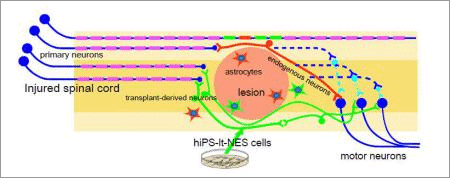Research outcomes
Treatment of spinal cord injury by transplantation of human neuroepithelial-like stem cells derived from iPS cell
The efficacy of transplanting neural stem cells (NSCs) derived from human induced pluripotent stem cells (hiPS-NSCs) for the treatment of spinal cord injury (SCI) has just begun to be investigated, using the mouse as a model. Recently, Professors Austin Smith (University of Cambridge) and Oliver Brustle (University of Bonn) and their coworkers have developed a protocol for generating long-term self-renewing neuroepithelial-like stem (lt-NES) cells, which satisfy the criteria to be defined as NSCs, from several different lines of human iPS cells.
In a collaboration with Professor Smith, Professor Kinichi Nakashima, team-member Yusuke Fujimoto and their coworkers in the Laboratory of Molecular Neuroscience, Graduate School of Biological Sciences have recently shown that transplanted human iPS-derived lt-NES (hiPS-lt-NES) cells have therapeutic potential for SCI treatment in the mouse model. They also suggested that hiPS-lt-NES cell transplantation promotes recovery of hind limb motor function through the reconstruction of the corticospinal tract, and restores disrupted neuronal circuitry in a relay manner. Their study raises the possibility that human iPS cell-derived NSCs can be used in the treatment of spinal cord injury in humans.

Fig.1 Mechanisms of functional recovery from SCI after hiPS-lt-NES cell transplantation. Transplanted hiPS-lt-NES cell-derived neurons (green cells with long processes), together with the surviving endogenous neurons (red cell with long processes), contributed to restored motor function. Both types of neurons reconstructed the corticospinal tract by forming synaptic connections and integrating neuronal circuits.

Fig.2 Transplantation of hiPS-lt-NES cells promotes functional recovery of hind limbs after SCI. Left, Untreated mice could not support their own weight. Right, mice with transplanted hiPS-lt-NES cells could support their body weight using their hind limbs.
[Press Release] March 15, 2012
( March 15, 2012 )
